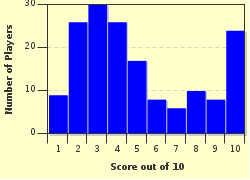Quiz Answer Key and Fun Facts
1. Which American author wrote: "If a man loses pace with his companions, perhaps it is because he hears a different drummer. Let him step to the music which he hears, however measured, or far away"?
2. The Drum Major of the 3rd U. S. Infantry Regiment "Old Guard Fife and Drum Corps" does not carry the traditional mace of a drum major. Which does he or she carry?
3. Which was the name of a type of drum likely used by a medieval drummer?
4. Which was the original title of the classic Christmas carol "The Little Drummer Boy"?
5. Written as a novel in 1956 and adapted to film in 1973, "Bang the Drum Slowly" was a story about which?
6. The 1958 Rodgers and Hammerstein Broadway musical "Flower Drum Song" (filmed 1961, Universal ) brought a Tony Award nomination for Best Leading Actress in a Musical to which actress?
7. The first type of drum to be used in orchestral performances over 300 years ago was the "timpani" or "kettle drum". The body or base of a timpani is constructed of which material?
8. In the performance of traditional Japanese "Gagaku" or classical Imperial court music, which was the drum?
9. Who was Aiken Drum?
10. In 1963, as the body of President John F. Kennedy was transported by horse-drawn caisson from the White House to the Capitol Rotunda to lie in state, which other instrument was played during the solemn procession in addition to muffled drums?
Source: Author
socalmiguel
This quiz was reviewed by FunTrivia editor
Bruyere before going online.
Any errors found in FunTrivia content are routinely corrected through our feedback system.

